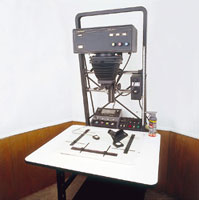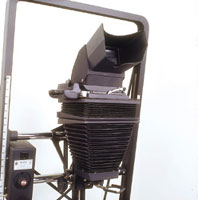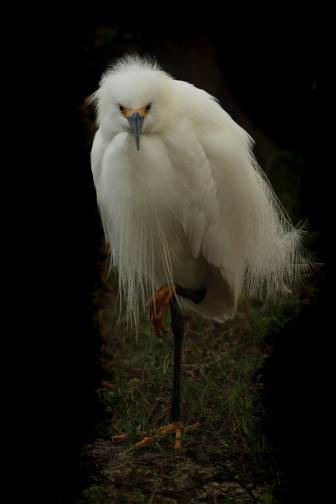Customizing Your Enlarger: Get It Your Way, While you Still Can
A little over a year ago, when I first conceived this article, my main idea was to dwell on after-market enlarger accessories and custom modifications. After attending several major photographic equipment shows, it has become evident that another angle deserves equal billing. To a veteran darkroom devotee like myself, enlargers, and other darkroom equipment, have been conspicuous by their near absence at these shows. The reason, of course, is the increasingly rapid transition to the digital darkroom. Now that high-resolution, large format ink jet printers are available for half the price of a good enlarger, the smells, stains, fumbling under dim safelights, and waste disposal hassles of the traditional "wet" darkroom are finding favor with fewer photographers, especially those new to the hobby/profession. With the introduction of archival black and white ink sets, even the fine art sector, the last staunch holdout, is finally being won over by pixel power. Whether this is a good or bad thing depends on your personal outlook, but, like it or not, the future is upon us, so we'd better get used to it. Personally, I view the digital genre as expanded imaging opportunities, rather than the whole- sale destruction of all that I hold dear. This doesn't mean that I have any desire to abandon my chemical-based darkroom; 40 years under dim amber lights is a habit that's hard to break. I enjoy both disciplines and will continue getting a buzz from watching a print come up in the developer tray, even if I have to start coating my own papers. |
|||
If you intend to stick with traditional darkroom pursuits, you need to compile a wish list for your enlarger. This should include any accessories you need, or even think you may need someday, the bottom line is don't wait--"someday" is now. As an illustration, if you bought your enlarger 10 or more years ago, dig out the manual, which usually had a list of accessories available at that time. Now compare it to the current accessory list (if that company is still in business). I think you'll be shocked at the atrophied selection offered today. The major items, such as heads, are likely still available (though with fewer choices), but the smaller items that made things more convenient or enjoyable have disappeared. Perhaps you like to use interesting old classic cameras for which film is still available. Maybe you've just acquired a neat little Olympus Pen F, or a half-frame 35mm SLR. Or a Minolta 110 SLR, a Kodak Instamatic Reflex (126), a 4x4cm "baby" Rolleiflex (127), or even a Minox A (8x11mm). But if you want to enlarge these "orphan" negative sizes, unless you plan on masking them off in a larger glass carrier, there are no carriers currently available in these formats. Or how about that camera support arm for converting your enlarger to a copy stand, the purchase of which you've had on the "back burner" for years? Is it still available? Probably not. How about a long, "XL" column or oversize baseboard? Wall mount? Lift motor? Focus motor? Recessed lensboard? Remote focus cable and a masking negative stage? Format-specific light mixing boxes for your color or VC head? Lens turret? Drop-in format masks for book-type negative carriers? Depending on your brand of enlarger and the length of your accessory wish list, this is either a mild wake-up call, or a panic attack. |
|||
If the manufacturer no longer makes the items you want, you have four options. The first is locating an item on the used market. The Shutter-bug advertisers are your best resource here, followed by the more "iffy" prospect of tracking it down online. The second possibility is to see if a comparable item is offered by an independent "after-market" supplier. Once a 50/50 chance, the odds have dwindled drastically, as the ever smaller pool of potential customers simply doesn't justify the cost of setup and production. After-market companies have also been a source of accessories that were never offered by the original manufacturer. The third option is adapting something to your needs. Take a remote focusing cable as an example. Consisting of a knob on a flexible cable that attaches to the focusing shaft (after removing the standard knob) of the enlarger, permitting focusing at high magnifications while viewing through a grain focuser, these were once commonly available. If no longer offered for your enlarger, then look in the yellow pages for a large telescope store. Astronomical telescope mounts that don't have electric drives usually have these flexible cable accessories available as "slow-motion attachments," in various lengths. You may have to enlarge or sleeve the end that attaches to your focusing shaft, but it's not a major operation. |
|||
Having an item made for you by a machine shop is option number four, which overlaps into the customizing premise of this article. Let's use negative carriers as an illustration. As a panoramic specialist, I need to enlarge the long, skinny negatives. Though the pan formats of 24x58mm, 24x65mm, 6x12cm, and 6x17cm have been with us for ages, precious few enlarger manufacturers have ever offered neg carriers in these formats. Since I prefer not to put up with the dust and Newton-rings hassle associated with masking off a larger glass carrier, I obtained carriers machined out to the required formats (for Beseler and Omega) from Pro Photo Connection, in Irvine, California, (800-732-6361). If you need a carrier for one of the previously mentioned orphan film formats, you can start with a smaller format carrier, then have the opening enlarged as needed. This is a lot less expensive than having an entire carrier machined from scratch. Another easy custom item is an oversize baseboard. If you've ever been annoyed because the base "legs" of your borderless easel keep dropping off the left/right edges of your too-narrow baseboard, this is a project for you. I was fortunate in locating an extended (31x36") baseboard for my Beseler shortly after it had been discontinued. Had I not lucked out, a trip to a cabinetmaker would have solved the problem. You can have one made in any size and topped in white or black Formica. Bring your old baseboard for the column attachment hole pattern, and emphasize the need for warp-free (now and forever) construction. More ambitious projects might include adapting your old 4x5 Beseler or Omega for use as a copy camera. After removing the lamp housing, have a machine shop make an intermediate adapter to attach a 4x5 ground-glass focusing back. Once that's done, a reflex viewer easily attaches to the back (check in advance for back/viewer compatibility before mixing brands). I used a 4x5 Cambo back, then adapted a reflex viewer from an old Polaroid MP-3 copy unit. I mount my enlarging lenses in a self-cocking Prontor Press shutter, also gleaned from the MP-3. Copal shutters are fine, too, but aren't self-cocking. The Beseler also allows tilting the "camera" 90 for horizontal copying of huge originals. Another common adaptation is combining one brand of lamp house with another brand of enlarger. Certain Beseler, Omega, and Durst swaps were so popular at one time that the companies involved offered adapters to fit their (usually color) heads to their competitors' enlargers. Aristo cold light heads (standard and VC) are available to fit nearly any enlarger. If you are contemplating a truly unorthodox marriage, make sure that the proposed lamp house will clear your enlarger's chassis at all heights. I've had my Beseler since 1986, and have managed to accumulate the majority of accessories needed. I have paid special attention to the light source (manual diffusion color head, also used for VC), adding 6x7cm and 35mm light mixing chambers (in addition to the standard 4x5 chamber), plus the condenser set (for sharp color for industrial subjects). Lens choices range from a 30mm capable of full-frame 35mm, a 55mm f/1.9, to a 50-80mm vari-focal, plus 50mm, 65mm, 90mm, and 135mm. The negative carriers pictured are less than half of my arsenal, which ranges from 8mm Minox to a 4x5 glass pin-registration carrier, a "film-stretcher" 4x5 Nega-Flat, one for mounted 35mm slides, and just about anything else in between, including pans and orphan formats. Since Beseler didn't offer a masking negative stage, I had one from a D-series Omega modified to fit into the Beseler carrier stage. Any future projects? Yes, at least three. First I will rewire the drive motor to allow mounting the control switch under the right-hand edge of the baseboard. Then I'll add a custom variable-speed motor to the focusing mechanism, with control integrated with the chassis motor switch. Finally I will have a pan-format vacuum easel fabricated (Schwarm-Geisenhofer: 303-680-0086). No doubt I'll think of others. So grab whatever accessories are still available--they likely won't be for long. I would also recommend looking into any possible replacement parts needed, with high-wear focusing and elevation components being the main concerns, including the bellows. Call your enlarger manufacturer and speak with a service technician; he'll know the parts that wear out most frequently, and may even have a refurbishing kit available for the more popular models. Your enlarger is your primary darkroom tool. With a little advance planning now, it will continue to serve you faithfully well into the new millennium. And with a bit of mechanical creativity and ingenuity, it can do so with far greater utility than its designers originally envisioned. |
- Log in or register to post comments





































